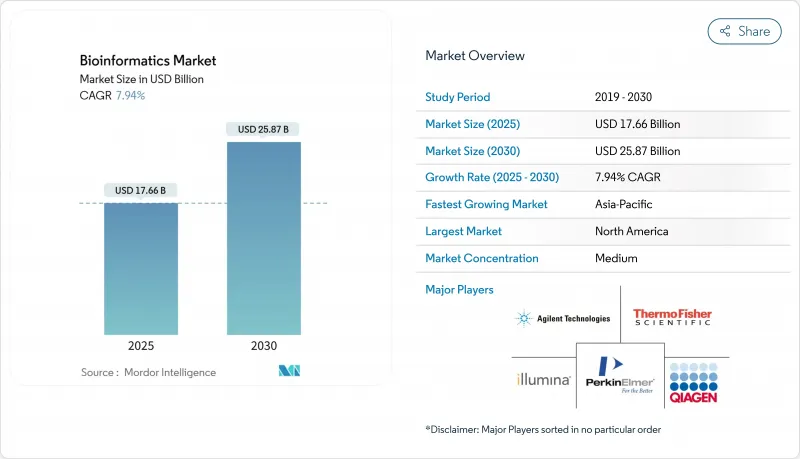
|
市場調査レポート
商品コード
1849975
バイオインフォマティクス:市場シェア分析、産業動向、統計、成長予測(2025年~2030年)Bioinformatics - Market Share Analysis, Industry Trends & Statistics, Growth Forecasts (2025 - 2030) |
||||||
カスタマイズ可能
適宜更新あり
|
|||||||
| バイオインフォマティクス:市場シェア分析、産業動向、統計、成長予測(2025年~2030年) |
|
出版日: 2025年06月10日
発行: Mordor Intelligence
ページ情報: 英文 125 Pages
納期: 2~3営業日
|
概要
バイオインフォマティクスの市場規模は2025年に176億6,000万米ドル、2030年には258億7,000万米ドルに達し、2025~2030年のCAGRは7.94%で拡大すると予測されています。

バイオインフォマティクス市場規模の拡大は、マルチオミクスデータ生成の急成長、AIアナリティクスの広範な展開、公的研究資金の着実な流入によってもたらされています。北米が最大のバイオインフォマティクス市場シェアで首位を維持しており、成熟したシーケンスインフラ、豊富なベンチャーキャピタルプール、精密医療の早期臨床導入に支えられています。アジア太平洋は、特に中国とシンガポールの国家ゲノムプログラムがデータ生産を加速し、現地の人材パイプラインを刺激しているため、最速の拡大を記録しています。
世界のバイオインフォマティクス市場の動向と洞察
シーケンスのコストは下がり続ける一方でスループットは上昇し、その結果、ペタバイトスケールのゲノム、トランスクリプトーム、プロテオミクスファイルがレガシーハードウェアを凌駕するようになりました。そのためラボは、バッチ、リアルタイム、ストリーミングのデータレイヤーを統合するパイプラインの近代化を進めています。国立ヒトゲノム研究所のMulti-Omics for Health and Disease Consortiumが2024年8月に更新したデータは、メタデータを標準化することで疾患のサブタイピングを容易にすることで、この動向を例証しています。ベンダーは現在、細胞のアノテーションとバリアントの影響予測を自動化するための基盤AIモデルを組み込んでおり、研究者はデータ整理よりも仮説生成に集中できるようになっています。その結果、市場ではセキュアなオブジェクトストレージとインシリコ処理の高速化に対する需要が高まっています。オンプレミスとクラウドのハイブリッドアーキテクチャの出現は、今後のバイオインフォマティクス業界の成長が柔軟な展開モデルに依存することを示唆しています。
臨床現場における精密医療とコンパニオン診断の採用増加
ヘルスケアシステムは、ゲノム解釈パイプラインを腫瘍学や希少疾患のワークフローに統合しており、規制に準拠したバイオインフォマティクスソフトウェアへの新たな需要を牽引しています。Caryl and Israel Englander Institute for Precision Medicineは、全エクソームシークエンシングがリアルタイムの治療決定をどのように導くかを示しています。2023年8月、米国立衛生研究所(National Institutes of Health)はゲノム対応学習型医療システムへの資金提供を発表しました。これらのシステムは、バリアントデータを電子カルテに接続し、HL7準拠のレポートモジュールを促進します。診療報酬モデルがデータ主導型医療をますます支持するようになり、病院は内部シーケンスラボに投資し、ユーザーフレンドリーな解釈ダッシュボードを活用しています。その結果、バイオインフォマティクス市場は研究機関から主流の臨床診断へと拡大しています。重要な洞察は、アルゴリズムの精度よりも、これらのシステムと病院のITインフラとの統合がベンダー選択に大きく影響するということです。
世界的な大規模政府資金によるゲノム・イニシアティブと官民コンソーシアム
ゲノミクスとバイオインフォマティクスに対する政府の資金援助は新たな高みに達しており、インフラ整備とデータ生成を通じて市場開拓のための強力な基盤を作り出しています。2024年7月、UK Research and InnovationはBioFAIRイニシアチブに3,400万ユーロ(3,700万米ドル)を投資します。このプロジェクトは、統一されたデジタル研究インフラを構築し、FAIRデータ原則を推進しながら、研究者と技術専門家の協力を促進することを目的としています。米国では、国立ヒトゲノム研究所(National Human Genome Research Institute)が、2023年度予算の約30%を、計算ゲノム・データ科学プログラム(Computational Genomics and Data Science Program)から、計算手法とデータ解析ツールの進歩に焦点を当てたプロジェクトに割り当てており、2025年3月に更新される予定です。シンガポールでは、2024年8月にOxford NanoporeおよびPacBioとの提携によるNational Precision Medicineプログラムの野心的なロングリードシーケンスプロジェクトが開始されます。このイニシアチブは、アジアの遺伝的多様性の理解を深め、アジア人集団の参照ゲノムを作成することを目指しています。さらに、大手製薬会社とのイルミナのAlliance for Genomic Discoveryのような官民コラボレーションにより、ゲノム研究と医薬品開発が加速しています。
セグメント分析
プラットフォームは2024年のバイオインフォマティクス市場シェアの48.3%を占め、配列アライメント、アノテーション、可視化の主要ハブとしての役割を検証しています。これらのスイートは、熟練したバイオインフォマティシャンにも初心者にもマルチオミクスワークフローを合理化するアルゴリズムライブラリとグラフィカルインターフェイスを統合しています。クラウドネイティブのバイオインフォマティクス-as-a-Serviceは、2030年まで17.3%のCAGRで成長すると予測されています。Elastic Compute、バンドルされたセキュリティ認証、マーケットプレースのアドオンにより、小規模ラボは社内のDevOpsの専門知識がなくても複雑なAIモデルを実行できるようになります。ベンダーは現在、コンテナ化されたワークフローと、サンプルごとのコストを追跡する課金ダッシュボードを組み合わせ、グラント管理者にきめ細かな財務可視性を提供しています。重要な推論として、定期的な消費による収益が永久ライセンスの売上を徐々に上回り、ベンダーの経済性が一変します。
地域分析
2024年、北米は、ゲノミクス研究に対する公的・私的な大規模投資により、市場の38.2%という圧倒的なシェアを獲得します。バイオインフォマティクス企業や研究機関の盛んなエコシステムが、この首位の座をさらに強固なものにしています。特に、NIHのComputational Genomics and Data Science Programに代表されるように、政府からの資金援助は極めて重要な役割を果たしています。このイニシアチブでは、国立ヒトゲノム研究所の予算の約30%を、計算ゲノム学とデータ科学を中心としたプロジェクトに充てています。米国は、特にAIや機械学習とゲノム解析の融合において、バイオインフォマティクスイノベーションの最前線に立っています。その証拠に、生物医学研究に特化した大規模な言語モデルを作成し、文脈を考慮した対応を強化するだけでなく、研究効率を高めています。さらに、この地域の洗練されたヘルスケアインフラと精密医療の早期導入により、臨床環境における高度なバイオインフォマティクスソリューションの需要が高まっています。
アジア太平洋地域は、2025年から2030年までのCAGRが14.5%と、他を圧倒する勢いです。この急成長の背景には、ゲノム研究、急成長するヘルスケアインフラ、精密医療に対する政府の投資の増加があります。その一例がシンガポールのNational Precision Medicineプログラムで、2024年8月に野心的なロングリード配列決定プロジェクトを開始しました。このイニシアチブは、アジアの遺伝的多様性の理解を深め、同大陸の人口の参照ゲノムを確立することを目的としています。一方、2024年5月、中国のBGIジェノミクス社は、世界的な拡大を続け、ウルグアイとハルビンに臨床ラボを開設しました。これらのラボは、アフリカにおける大腸がんリスク評価と公衆衛生活動に特化しています。さらに、アジア太平洋地域は、mRNA技術、個別化医療、AI主導の創薬によって、バイオ医薬品の領域でニッチを築きつつあります。しかし、この地域は教育や人材開発、特に欧米に比べプログラムが遅れている南アジア諸国での開発に課題を抱えています。
欧州は、その強力な研究機関と協力的な努力に支えられ、市場において特筆すべき地位を保持し続けています。2024年7月の英国研究革新庁による3,400万ユーロ(3,700万米ドル)のBioFAIR投資はその証です。このイニシアチブは、統一されたデジタル研究インフラの構築、FAIRデータ原則の支持、公平なデータアクセスの確保に対する欧州の献身を強調するものです。欧州のKEYWORDへの取り組みは、ゲノム研究におけるデータプライバシーと倫理的配慮への強いコミットメントにも大きく影響されています。この焦点は、イノベーションと責任あるデータ管理を調和させるバイオインフォマティクスソリューションを開発する原動力となっています。
その他の特典
- エクセル形式の市場予測(ME)シート
- 3ヶ月間のアナリストサポート
よくあるご質問
目次
第1章 イントロダクション
- 調査の前提条件と市場の定義
- 調査範囲
第2章 調査手法
第3章 エグゼクティブサマリー
第4章 市場情勢
- 市場概要
- 市場促進要因
- 高度な分析プラットフォームを必要とするマルチオミクスデータ量の指数関数的増加
- 臨床現場における精密医療とコンパニオン診断の導入増加
- データ中心の創薬に向けた製薬・バイオテクノロジー分野の研究開発費の増加
- 世界中の大規模な政府資金によるゲノム研究イニシアチブと官民コンソーシアム
- バイオインフォマティクスの農業、環境、産業バイオテクノロジーワークフローへの統合
- シーケンシングコストの継続的な低下と手頃な価格のクラウドコンピューティングパワー
- 市場抑制要因
- 熟練した人材の慢性的な不足バイオインフォマティクス人材と研修プログラム
- 断片化されたデータ標準がプラットフォームとデータベース間の相互運用性を損なう
- ゲノム情報に関するデータプライバシー、セキュリティ、倫理的懸念の高まり
- エンタープライズグレードのインフラストラクチャには高額な初期投資と継続的なメンテナンスコストがかかる
- 規制の見通し
- テクノロジーの見通し
- ポーターのファイブフォース
- 新規参入業者の脅威
- 買い手の交渉力
- 供給企業の交渉力
- 代替品の脅威
- 競争企業間の敵対関係
第5章 市場規模と成長予測
- 製品とサービス別
- ナレッジマネジメントツール
- バイオインフォマティクスプラットフォーム
- 配列解析プラットフォーム
- 配列アライメントプラットフォーム
- 配列操作プラットフォーム
- 構造および機能解析プラットフォーム
- マルチオミクス統合プラットフォーム
- バイオインフォマティクスサービス
- シーケンシングおよびデータ生成サービス
- データベース構築・管理サービス
- データ分析および解釈サービス
- クラウドネイティブのバイオインフォマティクス・アズ・ア・サービス(BaaS)
- 用途別
- ゲノミクスとトランスクリプトミクス
- プロテオミクスとメタボロミクス
- 医薬品の発見と開発
- 微生物ゲノミクス(メタゲノミクスとAMR)
- 精密医療と個別化医療
- 農業および動物ゲノム科学
- エンドユーザー別
- 製薬・バイオテクノロジー企業
- 学術研究機関
- 臨床および診断検査室
- 受託研究機関(CRO)
- 農業ゲノムおよび環境試験会社
- 地域
- 北米
- 米国
- カナダ
- メキシコ
- 欧州
- ドイツ
- 英国
- フランス
- イタリア
- スペイン
- その他欧州地域
- アジア太平洋地域
- 中国
- 日本
- インド
- 韓国
- オーストラリア
- その他のアジア
- 中東・アフリカ
- GCC
- 南アフリカ
- その他中東・アフリカ地域
- 南米
- ブラジル
- アルゼンチン
- その他南米
- 北米
第6章 競合情勢
- 市場集中度
- 市場シェア分析
- 企業プロファイル
- Illumina Inc.
- Thermo Fisher Scientific Inc.
- Qiagen N.V.
- Agilent Technologies Inc.
- PerkinElmer Inc.
- F. Hoffmann-La Roche Ltd.
- BGI Genomics Co. Ltd.
- DNAnexus Inc.
- Seven Bridges Genomics Inc.
- Dassault Systemes SE(BIOVIA)
- Genedata AG
- Partek Inc.
- 3rd Millennium Inc.
- Data4Cure Inc.
- Ontoforce NV
- Oracle Corporation(Oracle Healthcare)
- CLC bio(QIAGEN Digital Insights)
- Geneious(Biomatters)
- SoftGenetics LLC
- Gene42 Inc.
- Eagle Genomics Ltd.
- Wuxi NextCODE Genomics

